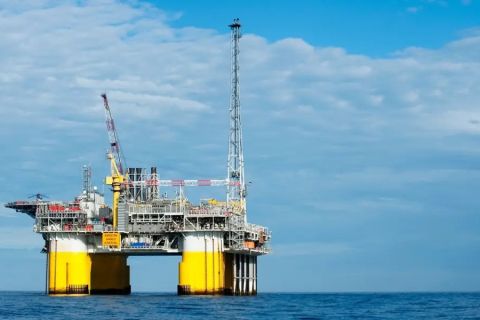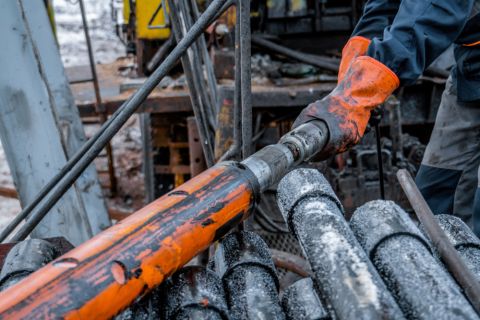It’s football season again, and similar to a quarterback gaining enough trust in a receiver that he gives him a hot read to “go long,” the Appalachian Basin has become even better with experience as the Utica Shale’s prolific output over the last seven years has given new life to the Midwest’s energy sector.
The Utica has become so strong that it’s hard to tell if it or its older brother, the Marcellus Shale, is the strongest play in the Appalachian Basin.
The Utica’s strength is best represented by the growth of production out of Ohio, which is home to the majority of the play. According to the Ohio Department of Natural Resources, gas production was up 5% to 4.3 billion cubic feet per day (Bcf/d) at the year’s midpoint. Crude production was down 17% from the previous year, but was still an impressive figure at more than 4 million barrels total.
Growing numbers
These numbers continue to grow, with RBN Energy LLC reporting that combined overall gas production from the Marcellus and Utica reached a record 25.3 Bcf/d in the fall of 2017.
According to RBN, the bulk of these gains are attributed not to a dramatic increase in production, but to increased pipeline takeaway capacity. This capacity has increased more than 2.4 Bcf/d since 2016 with more than 4 Bcf/d now in service. The days of record-breaking IP rates from new wells may be over, but the midstream is just getting started in the region.
“The Marcellus and Utica shales have lasted through some high and low times in the market and continue to be steady producers,” according to Jason Stechschulte, Marathon Pipe Line LLC’s (MPL) commercial development manager. “Now that more natural gas pipelines are coming online in the play, you can expect to see further upstream and midstream investment.”
Stechschulte said Marathon officials consider condensate production from the Marcellus and Utica as one because of how much their operations in the area—which are extensive—a overlap each other and the similarities with their product qualities. Marathon is a significant player in the region’s midstream, but also in downstream refining and marketing.
“Initially, we planned on segregating Marcellus and Utica production in the pipe, but over time we realized we didn't have to separate them. That’s a positive, since it requires less investment while still offering the same services,” he added.
Ahead of schedule
Marathon has invested heavily in the Appalachian Basin, most notably with the $1.28 billion acquisition of MarkWest Energy Partners by Marathon’s MLP, MPLX, in late 2015. MPLX ranks No. 8 on the current Hart Energy Midstream 50 of the sector’s largest players.
“MPL [also part of MPLX] was already operating important assets in the area and MarkWest is the largest natural gas processor and fractionator in the region. Each company's assets meet the demands of the other. In order to realize these synergies sooner, we accelerated portions of our pipeline projects following the acquisition,” Stechschulte said.
Since the acquisition, MPLX has sped up its Utica Build-Out and Cornerstone Pipeline projects. The 50-mile Cornerstone Pipeline was constructed to augment MPL’s condensate truck unloading facility in Canton, Ohio, which was its first midstream investment in the Utica. This pipeline terminates at Marathon’s Canton Refinery, where it supplies a 25,000 barrel-per-day (Mbbl/d) condensate splitter that was built in 2014, with deliveries now optimized between pipe and truck.
“We didn't know everything about the Utica when we made that investment, but we thought there was an opportunity,” Stechschulte said. He added that while a truck can deliver about 190 bbl of condensate, the pipeline can deliver that in about two minutes. However, all forms of transportation are still needed in the region and MPLX is investing in truck, barge, rail and pipeline projects.
Completed in July 2017, the Utica Build-Out was designed to connect the Midwest markets by extending a pipeline and upgrading multiple pump stations along existing pipelines. This added connectivity to the Husky refinery in Lima, Ohio; as well as two refineries in Toledo, Ohio; and the Marathon refinery in Detroit. The company also reversed the 250-mile RIO Pipeline, which ran from Robinson, Ill., to Lima. This reversal provided connectivity to the refinery in Robinson and access to Chicago and Mount Vernon, Ind., via some additional MPL pipelines from Robinson.
Canadian markets
Of course, the Midwest isn’t the only market for Utica production, as MPL has also built connectivity to Canadian diluent pipelines, including the Cochin and Southern Lights systems. MPL’s strategy has centered on providing solutions for producers, refiners and diluent blenders in Western Canada.
“We're trying to offer a wide array of options. We’re connected to 10 refineries throughout the Midwest, and now, the diluent market. Our goal is to offer flexibility and optionality rather than just focus on one specific market,” Stechschulte said.
“We’ve been fortunate in that we’ve been able to complete our projects on schedule and under budget. One of the challenges that we’ve faced has been that we’re trying to build the right assets for today’s needs while also considering future customer needs,” he added. In order to meet future demand, MPL’s Utica pipelines can be expanded for additional capacity.
From unknown to superstar
A lot can happen in five years. Although that may seem like a short time, consider that the Utica went from a virtual unknown in 2011 to one of the world’s largest shale plays by 2016. One of the early midstream players in the Utica and Marcellus was Blue Racer Midstream LLC, which entered in late 2012 and now has one of the most extensive rich gas-gathering systems in Appalachia
Blue Racer has 800 million cubic feet per day (MMcf/d) of gas processing nameplate capacity and about 1.5 Bcf/d of fractionation capacity. The company also has a significant lean gas-gathering business in the region, with about 350 MMcf/d in capacity.
Blue Racer was begun as a joint venture between private-equity firm Caiman Energy II LLC and Dominion Natrium Holdings Inc., an affiliate of Dominion Energy Inc. (formerly Dominion Resources Inc.). These assets helped the company weather the downturn when producers pulled rigs out of the play at significant levels throughout 2015 and 2016.
“In the early days, we were growing from scratch and had a huge backlog of wells that were drilled by our producers. As drilling slowed down, there was still that enormous backlog that was brought online. As that backlog was depleted, our producers started actively drilling again,” said Blue Racer CEO Stephen L. Arata.
Arata said the company is confident the play’s worst is behind it. “We’ve come through the trough period and going forward, our producers’ economics at today’s strip are outstanding in both lean and rich gas, in part due to drilling enhancements such as longer laterals and better completion techniques,” he said.
Nimble moves
Since it is a privately backed company, Blue Racer has a longer time horizon for investments relative to when it expects the assets to produce cash flow. “Unlike an MLP, we’re not spending the money and expecting to immediately pay distributions on the assets,” Arata said.
Blue Racer’s customer base includes 20 companies across the play, which is among the most diverse in the Utica. Arata said the company makes sure to work with customers on an individual basis rather than focus on a single large customer.
While its customer and asset bases are large, it’s still a small company with under 250 total employees. “There are not a lot of layers of management here, which allows us to address issues and come up with solutions on a pretty quick basis,” Arata added.
Being able to move quickly has allowed Blue Racer to build up one of the largest gathering systems that covers most of the Utica, as well as portions of the Marcellus. Its footprint covers most of Ohio with significant gathering assets into West Virginia. About 40% of the gas the company processes is Marcellus rich gas out of West Virginia.
“It helps to be nimble in a developing play since companies haven’t committed all of their acreage to a single midstream operator,” Arata said. Blue Racer’s extensive rich gas-gathering system is also a strategic advantage since producers can quickly tie into the system, he added.
“We don't have to lay a gas line more than a couple of miles to collect any molecule of gas in the play. The most challenging asset to build, particularly in a developing play, is a long 20- to 30-plus-mile, large-diameter pipeline that requires multiple customers to commit in order for the economics to work for the midstream operator. We have all of those lines already in place, so it’s very easy and efficient for us to get a customer’s gas online shortly after signing a contract,” he said.
Higher capex
Blue Racer’s 2018 capex is significantly higher than 2017’s, but the company doesn’t want to get too far ahead of its customers in adding capacity.
“That's one of the reasons we are running at 90% capacity. We want to stay ahead, but we don't want to have empty plants sitting around,” Arata added.
The company currently operates four cryogenic processing plants in the Utica, each with 200 MMcf/d of nameplate capacity. It also plans to build more similarly sized plants as demand increases.
Blue Racer would be able to bring its fifth plant online with six months’ notice and the sixth plant could be brought online with a year’s notice. With these two additional plants in operation, it would have a combined 1.2 Bcf/d of nameplate processing capacity.
Marcellus moves
With the Utica continuing to grow, it’s easy at times to forget about its older brother, but the Marcellus Shale is still the site of some of the most extraordinary production output in the world. The play accounts for nearly 40% of the country’s total natural gas output, though production is expected to remain relatively flat this year as demand catches up with production.
The midstream is doing its part to help on this end by adding new pipeline not just in the Utica, but in the Marcellus as well. This new pipe will increase takeaway capacity to nearly 8.5 Bcf/d in 2018. This capacity is helping move Marcellus production to new end-use markets.
One of the largest pipeline projects in the Marcellus is Williams Partners LP’s Atlantic Sunrise project, which will expand the existing Transco natural gas pipeline system by looping the Leidy Line in Pennsylvania and adding about 183 miles of new pipeline called the Central Penn North and Central Penn South. This project, which was scheduled to be complete in August, will transport up to 1.7 Bcf/d of Marcellus gas to markets in the Mid-Atlantic and Southeast. (See the adjoining story for more on Atlantic Sunrise.)
The opposition
While the Appalachian Basin is filled with good energy news, midstream developers are facing challenges from environmental groups that are seeking to delay or block several important projects in the region. The most notable of these challenges has been EQT Midstream Partners’ Mountain Valley Pipeline, which has had two key sections of its proposed 303-mile system successfully blocked by the Sierra Club and other environmentalist groups. This project is designed to transport up to 2 Bcf/d of natural gas from Wetzel County, W.Va., to Pittsylvania, Va.
The 4th U.S. Circuit Court of Appeals accepted the Sierra Club’s argument that a 3.6-mile segment of the Mountain Valley Pipeline would disrupt and erode woodlands in Virginia and West Virginia. The court has asked the U.S. Forest Service and the U.S. Bureau of Land Management to further review their previously approved licenses for this project. It’s unclear how long this delay could last, but it almost surely will increase the project’s price from the currently estimated figure of $3.5 billion.
While EQT faces challenges for this project, the company’s midstream segment continues to grow with the creation of a new company, which has yet to be named.
This company will incorporate the midstream assets of EQT Corp., which were dropped down to EQT Midstream Partners, along with assets in Rice Midstream Partners. EQT Midstream Partners will remain a separate publicly traded entity when the new midstream venture goes public in the third quarter. This new venture will be the third-largest gas gathering company in the country and have a huge focus on the Marcellus and Utica. EQT Midstream ranks No. 21 on the Midstream 50.
Prior to this merger, EQT sold its southern Appalachian producing gas and oil and midstream assets to Diversified Gas & Oil for $575 million. This sale included 6,400 miles of gathering pipeline and 59 compressor stations in Kentucky, Virginia and West Virginia.
As more operators like MPLX, Blue Racer, Williams and EQT continue building in the Utica and Marcellus shales, the region will keep moving from rookie standout to the industry’s MVP.
Frank Nieto is a freelance writer based in Washington, D.C.
Recommended Reading
Oil States’ ACTIVEHub for Digitized Assets
2024-03-14 - Oil States Energy Services’ new ACTIVEHub system and ACTIVELatch help operators remotely monitor and automate frac locations for a more efficient and safer wellsite.
Tech Trends: AI Increasing Data Center Demand for Energy
2024-04-16 - In this month’s Tech Trends, new technologies equipped with artificial intelligence take the forefront, as they assist with safety and seismic fault detection. Also, independent contractor Stena Drilling begins upgrades for their Evolution drillship.
2023-2025 Subsea Tieback Round-Up
2024-02-06 - Here's a look at subsea tieback projects across the globe. The first in a two-part series, this report highlights some of the subsea tiebacks scheduled to be online by 2025.
TGS, SLB to Conduct Engagement Phase 5 in GoM
2024-02-05 - TGS and SLB’s seventh program within the joint venture involves the acquisition of 157 Outer Continental Shelf blocks.
StimStixx, Hunting Titan Partner on Well Perforation, Acidizing
2024-02-07 - The strategic partnership between StimStixx Technologies and Hunting Titan will increase well treatments and reduce costs, the companies said.





